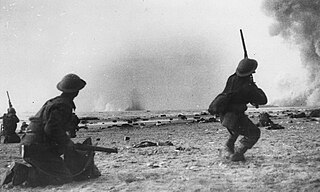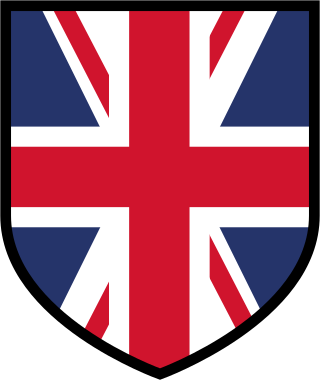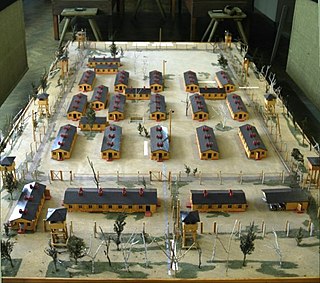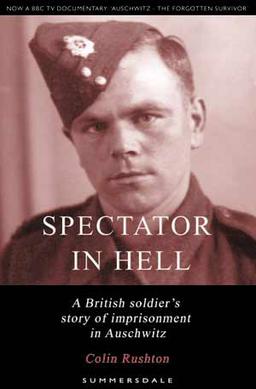Related Research Articles

A prisoner of war (POW) is a person who is held captive by a belligerent power during or immediately after an armed conflict. The earliest recorded usage of the phrase "prisoner of war" dates back to 1610.

The Battle of Dunkirk was fought around the French port of Dunkirk (Dunkerque) during the Second World War, between the Allies and Nazi Germany. As the Allies were losing the Battle of France on the Western Front, the Battle of Dunkirk was the defence and evacuation of British and other Allied forces to Britain from 26 May to 4 June 1940.

The British Free Corps was a unit of the Waffen-SS of Nazi Germany during World War II, made up of British and Dominion prisoners of war who had been recruited by Germany. The unit was originally known as the Legion of St George. Research by British historian Adrian Weale has identified 54 men who belonged to this unit at one time or another, some for only a few days. At no time did it reach more than 27 men in strength.

The Dunkirk evacuation, codenamed Operation Dynamo and also known as the Miracle of Dunkirk, or just Dunkirk, was the evacuation of more than 338,000 Allied soldiers during the Second World War from the beaches and harbour of Dunkirk, in the north of France, between 26 May and 4 June 1940. The operation commenced after large numbers of Belgian, British, and French troops were cut off and surrounded by German troops during the six-week Battle of France. In a speech to the House of Commons, British Prime Minister Winston Churchill called this "a colossal military disaster", saying "the whole root and core and brain of the British Army" had been stranded at Dunkirk and seemed about to perish or be captured. In his "We shall fight on the beaches" speech on 4 June, he hailed their rescue as a "miracle of deliverance".

The European theatre of World War II was one of the two main theatres of combat during World War II. It saw heavy fighting across Europe for almost six years, starting with Germany's invasion of Poland on 1 September 1939 and ending with the Western Allies conquering most of Western Europe, the Soviet Union conquering most of Eastern Europe and Germany's unconditional surrender on 8 May 1945 although fighting continued elsewhere in Europe until 25 May. On 5 June 1945, the Berlin Declaration proclaiming the unconditional surrender of Germany to the four victorious powers was signed. The Allied powers fought the Axis powers on two major fronts as well as in a strategic bombing offensive and in the adjoining Mediterranean and Middle East theatre.

Stalag XX-A was a German World War II prisoner-of-war camp located in Toruń in German-occupied Poland. It was not a single camp and contained as many as 20,000 men at its peak. The main camp was located in seven forts of the 19th-century Toruń Fortress, located in the southern part of the city.

"The March" refers to a series of forced marches during the final stages of the Second World War in Europe. From a total of 257,000 western Allied prisoners of war held in German military prison camps, over 80,000 POWs were forced to march westward across Poland, Czechoslovakia, and Germany in extreme winter conditions, over about four months between January and April 1945. This series of events has been called various names: "The Great March West", "The Long March", "The Long Walk", "The Long Trek", "The Black March", "The Bread March", and "Death March Across Germany", but most survivors just called it "The March".

In Germany, stalag was a term used for prisoner-of-war camps. Stalag is a contraction of "Stammlager", itself short for Kriegsgefangenen-Mannschaftsstammlager, a literal translation of which is "War-prisoner" "enlisted" "main camp". Therefore, technically "stalag" simply means "main camp".
Allied war crimes include both alleged and legally proven violations of the laws of war by the Allies of World War II against either civilians or military personnel of the Axis powers. At the end of World War II, many trials of Axis war criminals took place, most famously the Nuremberg Trials and Tokyo Trials. In Europe, these tribunals were set up under the authority of the London Charter, which only considered allegations of war crimes committed by people who acted in the interests of the Axis powers. Some war crimes involving Allied personnel were investigated by the Allied powers and led in some instances to courts-martial. Some incidents alleged by historians to have been crimes under the law of war in operation at the time were, for a variety of reasons, not investigated by the Allied powers during the war, or were investigated but not prosecuted.

Stalag IX-B was a German World War II prisoner-of-war camp located south-east of the town of Bad Orb in Hesse, Germany on the hill known as Wegscheideküppel. The camp originally was part of a military training area set up before World War I by the Prussian Army.
John Henry Owen Brown DCM was a Quartermaster Sergeant in the Royal Artillery in the British Army, who served in France at the beginning of the Second World War. He was one of Britain's most successful espionage agents as a prisoner of war following his capture by German forces, and, following the war's conclusion, acted as a prosecution witness in trials for treason.

Stalag VIII-A was a German World War II prisoner-of-war camp, located just to the south of the town of Görlitz in Lower Silesia, east of the River Neisse. The location of the camp lies in today's Polish town of Zgorzelec, which lies over the river from Görlitz.
Events from the year 1940 in the United Kingdom. The year was dominated by Britain's involvement in the Second World War, which commenced in September the previous year, as well as the numerous enemy air raids on Britain and thousands of subsequent casualties. Although the war continued, Britain did triumph in the Battle of Britain and Nazi Germany's invasion attempt did not take place.
Stalag IX-C was a German prisoner-of-war camp for Allied soldiers in World War II. Although its headquarters were located near Bad Sulza, between Erfurt and Leipzig in Thuringia, its sub-camps – Arbeitskommando – were spread over a wide area, particularly those holding prisoners working in the potassium mines, south of Mühlhausen.

Sharnbrook Academy, formerly Sharnbrook Upper School until 2017, is a large, rural academy school located in Sharnbrook, a village in the English county of Bedfordshire. Built in 1975, the school now has over 1900 students and around 300 staff, and includes a large sixth form founded in 1978 of around 650 students.
This is a timeline of World War II events that took place in 1940, the first full year of the second global war of the 20th century.

Arthur Dodd served in the British Army during World War II. After being captured at Tobruk, he became a Prisoner of War and was imprisoned at E715, an Allied POW camp attached to Auschwitz III (Monowitz), a sub-camp of the notorious Auschwitz.

As Allied troops entered and occupied German territory during the later stages of World War II, mass rapes of women took place both in connection with combat operations and during the subsequent occupation of Germany. Scholars agree that the majority of the rapes were committed by Soviet occupation troops. The wartime rapes were followed by decades of silence.
Elaine Marie Madden aka Meeus, aka Iomgen was a Belgian-born British agent of the Special Operations Executive during the Second World War. She was born in Poperinghe, Belgium and attended the British Memorial School in Ypres. She died in 2012 in Pont-Saint-Esprit, France.

During World War I (1914–1918), Wales was part of the United Kingdom of Great Britain and Ireland, which entered the war in August 1914 as one of the Entente Powers, along with France and Russia. In part as an effect of chain ganging, the UK decided due to geopolitical power issues to declare war on the Central Powers, consisting of Germany, Austria-Hungary, the Ottoman Empire, and Bulgaria.
References
- ↑ "Sean Longden biography". Andrew Lownie Literary Agency. Retrieved 26 December 2015.
- ↑ "Alumni Pages - Sean Longden". Sharnbrook Upper School. 28 November 2013. Retrieved 26 December 2015.
- ↑ Gardiner, Juliet (29 March 2012). "Review - Blitz Kids: The Children's War Against Hitler". HistoryExtra. Retrieved 26 December 2015.